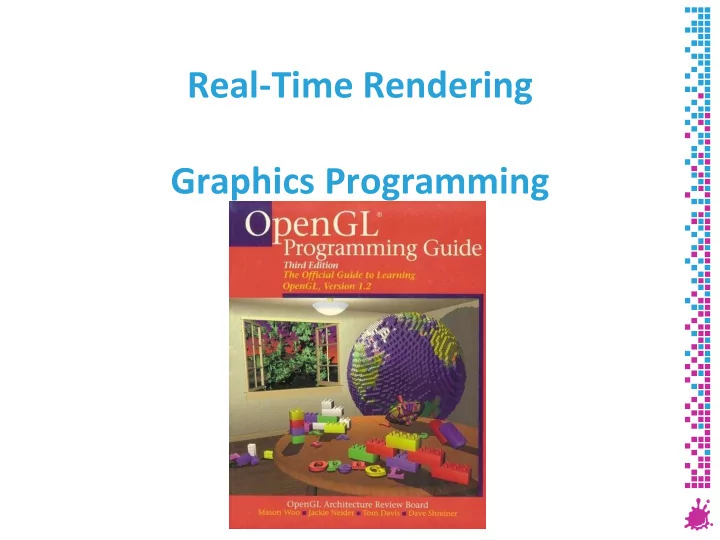

Real-Time Rendering Graphics Programming
Graphics Libraries (APIs) Give access to graphics hardware… Declarative (What, not How) Describe the scene (e.g., scene graphs) SGI Open Inventor, SGI Performer, Renderman, OpenSceneGraph… Imperative (How, not What) Sequence of drawing commands OpenGL, DirectX (Direct3D), Postscript More direct control Vienna University of Technology 2
Graphics Libraries (APIs) Using a scene graph API… Application Scenegraph Windows/Linux OpenGL Hardware Vienna University of Technology 3
Graphics Libraries (APIs) Using an immediate- mode API… Application GLUT Windows/Linux OpenGL Hardware Vienna University of Technology 4
The OpenGL Graphics System Web site: www.opengl.org OpenGL trademark owned by SGI More than 70 licensees OpenGL was controlled by the “ARB” Architecture Review Board Compaq, IBM, Intel, Microsoft, SGI, Evans & Sutherland, HP, Sun, NVidia, ATI, Apple Meeting notes on the Web follow ARB decisions, discussions, … Vienna University of Technology 6
Khronos Group Foundation: 2000 Supersedes ARB ~100 member companies Many APIs OpenGL (since 2006) OpenGL ES OpenVG OpenCL WebGL Collada Vulkan … Vienna University of Technology 7
Short History of OpenGL 1982 Silicon Graphics (SGI) incorporated 1983 IRIS GL on IRIS 1000 terminal (the predecessor to OpenGL) 1991 OpenGL ARB created 1992 OpenGL 1.0 (June 30) 1995 OpenGL 1.1 1996 OpenGL specification made public 1998 OpenGL 1.2 2000 OpenGL goes open source 2001 OpenGL 1.3 2002 OpenGL 1.4 2003 OpenGL 1.5 2004 OpenGL 2.0 (Shaders) 2008 OpenGL 3.0 (Depreciation model) 2008 OpenGL 3.0 (Depreciation model) 2009 OpenGL 3.2 (Geometry shaders) 2010 OpenGL 4.0 (Tesselation) Vienna University of Technology 9
A Short OpenGL Freshup All primitives made up of vertices… GL_LINES GL_LINES GL_POLYGON GL_POLYGON GL_LINE_STRIP GL_LINE_LOOP GL_LINE_STRIP GL_LINE_LOOP GL_POINTS GL_POINTS GL_TRIANGLES GL_TRIANGLES GL_QUADS GL_QUADS GL_TRIANGLE_FAN GL_TRIANGLE_FAN GL_TRIANGLE_STRIP GL_TRIANGLE_STRIP GL_QUAD_STRIP GL_QUAD_STRIP Vienna University of Technology 11
OpenGL Programming Model OpenGL is a state machine All commands change state Fixed function: only glVertex causes action This is still the “model” Superseded by new “macro” commands (glDrawBuffers, glDrawElements, …) Vienna University of Technology 12
Vienna University of Technology 13
OpenGL Design Goals Platform independent (unlike DirectX) Window-system dependent code separate (GLX, WGL) Implementations on Windows, Linux, MacOS, Be, OS/2, Unix, … Language independent (bindings for C, Java, Fortran, …) Consistency (unlike DirectX) Tightly written specification Conformance tests and required verification Not too tight: not pixel exact Invariance across passes (for correct multipass) Vienna University of Technology 14
OpenGL Design Goals Complete implementations (unlike DirectX) Missing hardware features emulated in software Silent error recovery Clean interface (unlike DirectX) State machine Most states are orthogonal (i.e., don’t influence each other, no side effects!) Extensibility (unlike DirectX) Favors innovation New HW features first available on OpenGL! Vienna University of Technology 15
More Goals High quality Intuitive usability (beauty counts) Good documentation (Programming Guide) Long life… Vienna University of Technology 16
OpenGL Problems Extensibility Different extensions for different GPUs Hell for production code (games) Design by committee Unified extension interfaces take long time Very slow to adopt non-GPU specific features (e.g., offscreen buffers) Non-existent toolset Shading debuggers (but: gDebugger) Performance tools (but: NVIDIA Parallel NSight) Mesh tools (already included in DirectX) Mediocre driver support Vienna University of Technology 17
OpenGL Extensions SGI maintains central registry Carefully documented Takes into account previous extensions New OpenGL version could be implemented by applying all extensions A bit difficult to read Read overview, then “Additions to…” Very stable process Extensions are refined and improved… Vienna University of Technology 18
OpenGL Extension Categories Proprietary: suffixed with vendor e.g., SGIS_texture_lod, NV_fragment_program EXT suffix Implemented by at least 2 vendors (usually NV,AMD) e.g. EXT_blend_func_separate ARB suffix Specification controlled by ARB ARB_multitexture 1.x: no suffix Required feature for version 1.x Vienna University of Technology 19
Vienna University of Technology 20
Vienna University of Technology 21
Vienna University of Technology 22
Vienna University of Technology 23
Using Extensions Get glext.h from www.opengl.org Check for extension availability Acquire function pointer(s) (only Win32) Easier : google “ opengl loading library” Vienna University of Technology 24
OpenGL 2.0 Main novelty: shading language GLSL Vertex and fragment shaders Replace fixed functionality Shader: high-level language (C-like) OpenGL driver: compiler and linker for shaders Vertex-, texture coordinates etc.: abstract input values to shader function Arbitrary calculations possible Requires DX9 (GeforceFX/6) cards Vienna University of Technology 25
OpenGL 3.0 Not much new Vertex Array Objects (encapsulate VBO state) Framebuffer objects (offscreen rendering) sRGB framebuffers Texture arrays Transform feedback Conditional rendering Extensions: geometry shaders, instancing, ... Depreciation mechanism! Vienna University of Technology 26
OpenGL 3.2 Geometry shaders Synchronization primitives Core profile/compatibility profile Vienna University of Technology 27
OpenGL 4.0/3.3 Tessellation Timer queries Double precision floating point Etc. OpenGL 3.3: for compatibility with older hardware Vienna University of Technology 28
OpenGL 4+ OpenGL 4.1: minor stuff (OpenGL ES 2.0 compatibility) OpenGL 4.2: minor stuff (atomic counters, …) OpenGL 4.3: Compute Shaders, shader buffers, debugging, OpenGL ES 3.0 compatibility, texture views OpenGL 4.4: minor stuff (bindless textures, memory transfer optimizations, …) Vienna University of Technology 29
OpenGL ES For embedded systems Reduced instruction set Developers love it OpenGL 4.3 is backwards compatible with OpenGL ES 3.0! Vienna University of Technology 30
Vulkan Designated OpenGL successor Adapted from AMD Mantle Binary intermediate format for shaders (SPIR) Client-controlled command buffers VK_CMD_BUFFER_BEGIN_INFO info = { ... }; vkBeginCommandBuffer(cmdBuf, &info); vkCmdDoThisThing(cmdBuf, ...); vkCmdDoSomeOtherThing(cmdBuf, ...); vkEndCommandBuffer(cmdBuf); Render passes VK_RENDER_PASS_CREATE_INFO info = { ... }; VK_RENDER_PASS renderPass; vkCreateRenderPass(device, &info, &renderPass); Vienna University of Technology 31
Recommend
More recommend